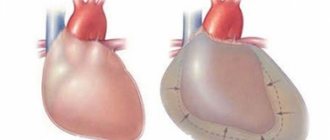Acromegaly is a pathology that manifests itself in an increase in the size of certain parts of the body; it is associated with increased production of growth hormone (somatotropin), which occurs as a result of tumor damage to the pituitary gland.
This phenomenon occurs in adult patients, its features are growth of the lower jaw, lips, ears, nose, growth of hands, feet, pain in the joints and head, interruptions in reproduction in females and males.
Elevated hormonal levels provoke premature death from heart, vascular, pulmonary and cancer diseases. Progression of acromegaly occurs after overall growth of the body stops. Little by little, over a long period of time, an increase in symptoms occurs, which is accompanied by changes in appearance. On average, the disease is diagnosed 7 years after its actual onset. Acromegaly can be found equally in both men and women; the age of patients is predominantly 40-60 years.
Description
Acromegaly is a pathological process in which the functionality of the anterior pituitary gland is disrupted.
The disease acromegaly manifests itself after the end of growth, accompanied by expansion of the facial parts of the skull, feet and hands. The provocateur of acromegaly is an increase in the concentration of somatotropic hormone. The development of the disease during adolescence is called gigantism.
Root causes and stages of acromegaly
The pituitary gland produces somatotropic hormone (GH), which is responsible for the formation of the musculoskeletal skeleton in childhood, and in adults it controls water-salt metabolism.
In patients with acromegaly, there is a disruption in the production of this hormone and an increase in its concentration in the blood. Pituitary adenoma with acromegaly occurs when pituitary cells grow.
Experts consider the most common cause of acromegaly to be a pituitary adenoma, which can form in the presence of hypothalamic tumors, head injuries, and chronic sinusitis. Hereditary factors play a major role in the development of acromegaly.
Acromegaly is characterized by a long-term course, its manifestations depend on the stage of development:
- Preacromegaly is characterized by a slight increase in the level of growth hormone, as a result of which there are virtually no signs of pathology;
- Hypertrophic stage – clearly defined symptoms of the disease are observed;
- The tumor stage is characterized by increased intracranial pressure and disturbances in the functioning of the visual and nervous systems;
- Cachexia – the patient is exhausted.
Due to the long development, no external signs are observed in the first stage of acromegaly.
Clinical manifestations
Symptoms of acromegaly in children and adults include:
- Pain in the spinal column and joints due to their destabilization and the development of arthropathy;
- Excessive male pattern hair growth in women;
- Expansion of spaces between teeth, enlargement of various parts of the face, thickening of the skin;
- The appearance of villous-warty growths;
- Enlarged thyroid gland;
- Decreased ability to work, fatigue;
- Development of cardiovascular pathologies that can lead to death;
- Development of diabetes mellitus;
- Impaired pigmentation of the skin;
- Respiratory system dysfunction.
With acromegaly of the pituitary gland, compression of healthy cells occurs, causing:
- Decreased potency and libido in men;
- Infertility, menstrual irregularities in women;
- Frequent migraines that cannot be treated with medication.
Diagnosis
A diagnosis of acromegaly and gigantism is possible based on data: MRI of the brain, symptoms, x-ray of the foot, biochemical parameters.
Laboratory tests include determination of the concentration of growth hormone and insulin-like growth factor-1. Normally, the level of growth hormone is no more than 0.4 μg/l, and IRF-1 corresponds to standard indicators according to the sex and age of the subject. In case of deviations, the presence of the disease cannot be excluded.
X-rays of the foot are performed to assess the thickness of its soft tissues. Reference values for men are up to 21 mm, for women – up to 20 mm.
If the diagnosis has already been established, the pathogenesis of acromegaly is studied and abnormalities in the functioning of the pituitary gland and hypothalamus are determined.
Computed tomography of the pelvic organs, chest, retroperitoneum, and mediastinal organs is performed in the absence of pathologies of the pituitary gland and the presence of biochemical and clinical manifestations of acromegaly disease.
Therapeutic measures for acromegaly
The main goal of therapeutic measures for such pathology is to normalize the production of somatotropin, that is, to bring it into a state of remission.
The following methods are used for this:
- Surgical therapy is used in two types: transcranial and transsphenoidal. The choice is made by a neurosurgeon. Surgery is performed to remove a microadenoma or partial resection of a macroadenoma.
- Radiation irradiation is carried out if there is no effect after surgical therapy; gamma knives, a proton beam, or a linear accelerator can be used for this.
- For drug therapy, the following groups of drugs are used: somatotropic hormone antagonists, somatostatin analogues, dopaminergic agents.
- The combined treatment method is used according to the doctor’s recommendations.
The choice of therapeutic measures should be carried out in conjunction with a specialist who has studied the pathogenesis of acromegaly, symptoms and results of biochemical studies of the patient.
According to statistics, surgical intervention is considered the most effective; about 30% of those operated on recover completely, and the rest experience a period of stable remission.
For preventive purposes it is recommended:
- Promptly treat diseases affecting the nasopharynx;
- Avoid head trauma.
If any doubtful signs occur, consult an endocrinologist. You should not carry out diagnosis, much less treatment, on your own.
Prognosis for the patient
Improvement of the patient's condition depends on timely detection of the disease and the appointment of correct treatment. If the disease is left to chance, the disease progresses, the risk of a malignant tumor increases, and death is possible. Life expectancy is reduced; most patients do not live to see 60 years of age.
Any treatment for acromegaly will be ineffective without following an appropriate diet and proper lifestyle. It is advisable to consume as many calcium-rich foods as possible to strengthen bones. Products containing estrogen can suppress the production of growth hormone.
Symptoms
Photo: g2.nh.ee
Clinical manifestations of acromegaly are caused by increased production of somatotropin - a specific growth hormone that is synthesized by the pituitary gland, or by diseases that cause the development of tumor formations (pituitary adenomas, brain tumors, metastases from distant organs).
The reasons for the development of the disease lie in the overproduction of somatotropic hormone, which is of a primary pituitary nature or has a hypothalamic origin.
It is generally accepted that a pathological process that develops at an early age, with an advantage in adolescence, is called gigantism. A characteristic feature of gigantism in children is the rapid and proportional growth of organs, tissues, skeletal bones, and hormonal changes. A similar process that develops after the body stops growing in adulthood is called acromegaly. The characteristic symptoms of acromegaly are a disproportionate increase in organs, tissues and bones of the body, as well as the development of concomitant diseases.
Signs of gigantism in children
Early signs of acromegaly (gigantism) in children can be detected some time after the onset of its development. Outwardly, they manifest themselves in increased growth of the limbs, which unnaturally thicken and become loose. At the same time, you can notice that the cheekbones and brow ridges are enlarged, hypertrophy of the nose, forehead, tongue and lips occurs, as a result of which facial features change, becoming rougher.
Internal disorders are characterized by swelling in the structures of the throat and sinuses, which causes a change in the timbre of the voice, making it deeper. Some patients complain of snoring. In the photo, acromegaly in children and adolescents is manifested by high growth, unnaturally enlarged parts of the body, elongated limbs due to uncontrolled expansion of the bones. The development of the disease is also accompanied by hormonal changes, the symptoms of which are:
- increased sweating;
- hypersecretion of the sebaceous glands;
- increased blood sugar levels;
- increased calcium levels in urine;
- the likelihood of developing cholelithiasis;
- swelling of the thyroid gland and disruption of its functioning.
Often at an early age, a characteristic proliferation of connective tissues is observed, which causes the appearance of tumor formations and changes in internal organs: heart, liver, lungs, intestines. Quite often you can see in the photo of newborn children with acromegaly of the neck, a characteristic feature of which is the elongation of the sternocleidomastoid muscle.
Symptoms of acromegaly in adults
Overproduction of somatotropic hormone causes pathological disorders in the body of an adult, which lead to changes in his appearance, which can be clearly seen in his photo or in personal contact. As a rule, this manifests itself in disproportionate growth of certain parts of the body, including the upper and lower extremities, hands, feet, and skull. Just like in children, in adult patients the forehead, nose, shape of the lips, brow ridges, cheekbones, and lower jaw change, resulting in increased interdental spaces. Most patients experience macroglossia, a pathological enlargement of the tongue.
Symptoms of acromegaly, the cause of which in adults in most cases is a pituitary adenoma, include skeletal deformation, in particular, curvature of the spinal column, enlargement of the chest with subsequent expansion of the intercostal spaces, and pathological changes in the joints. Hypertrophy of cartilage and connective tissue leads to limited joint mobility, resulting in the development of arthralgia.
Patients often complain of frequent headaches, fatigue, muscle weakness, and decreased performance. This is due to an increase in muscle size with subsequent degeneration of muscle fibers. At the same time, the appearance of myocardial hypertrophy is possible, turning into myocardial dystrophy, causing the development of heart failure.
Patients whose symptoms of acromegaly progress are often identified in photographs by characteristic changes in appearance that make them look similar to each other. However, internal organs and systems also undergo changes. Thus, in women, the menstrual cycle is disrupted, infertility develops, and galactorrhea is the secretion of milk from the nipples in the absence of pregnancy. Many patients, regardless of gender and age, are diagnosed with sleep apnea syndrome, which causes severe snoring.
In the absence of treatment, as a rule, the prognosis remains disappointing. The progression of pathological disorders leads to complete disability and also increases the risk of premature death, which occurs as a result of heart disease. The life expectancy of patients with acromegaly is significantly reduced and does not reach 60 years.
Stages
There are 4 stages of acromegaly:
- preacromegaly;
- hypertrophic;
- tumor;
- cachectic.
The first stage is diagnosed extremely rarely due to the mild severity of the symptoms characteristic of acromegaly.
At the hypertrophic stage, acromegaly can be recognized by the enlargement of individual organs, changes in facial contours and protrusion of the lower jaw. Characteristic features at this stage include deepening of the voice, increased body weight, and visual impairment. There are frequent cases of increased sweating due to the fact that the sweat glands also increase in size. General weakness and headaches are also included in the clinical picture of hypertrophic acromegaly.
At the tumor stage, the patient develops increased intracranial pressure. The consequence of this may be severe headaches, decreased hearing and vision. The tumor stage of acromegaly is often accompanied by muscle atrophy and weakness.
The outcome of the disease is considered to be the cachectic stage. This is complete exhaustion that develops in the absence of therapy.
Diagnostics
Photo: krasnayakrov.ru
Diagnosing acromegaly is quite simple, especially in the later stages, since its external manifestations are specific. However, there is a certain category of diseases whose symptoms are in many ways similar to those of acromegaly. To carry out differential diagnosis and confirm (or exclude) the presence of acromegaly, a consultation with an endocrinologist is prescribed, as well as visual, laboratory and instrumental methods for diagnosing acromegaly.
Visual examination of the patient
Before prescribing the necessary diagnostic procedures and proper treatment, the doctor collects anamnesis, determines the hereditary predisposition to the development of this disease, and also conducts an objective examination - palpation, percussion, auscultation. Based on the results of the initial examination, the necessary diagnostic procedures are prescribed.
Laboratory diagnostic methods
To diagnose acromegaly, traditional laboratory research methods are used: blood and urine tests. However, the most informative and therefore frequently used of them are considered to be the determination of hormones in the blood for acromegaly: STH - somatotropic growth hormone, and insulin-like growth factor - IGF-1.
Determination of the level of growth hormone
Confirmation of the development of gigantism or acromegaly is an increased level of somatotropin in the blood - growth hormone, which is produced by the anterior lobe of the pituitary gland. A distinctive feature of the production of growth hormone is its cyclical nature, therefore, to conduct a test to determine its level, multiple blood sampling is practiced:
- in the first case, three samples are taken with an interval of 20 minutes, after which the serum is mixed and the average level of growth hormone is determined;
- in the second case, blood is drawn five times with an interval of 2.5 hours, but the level is determined after each portion of blood is received. The final indicator is obtained by averaging all values.
Confirmation of the diagnosis of acromegaly is possible when the hormone level exceeds 10 ng/ml. The disease can be excluded if the average value does not exceed 2.5 ng/ml.
Determination of IGF-1 level
Another informative screening test is to determine the level of the hormone IGF-1. It has high sensitivity and specificity, since it does not depend on daily fluctuations, like somatotropin. If the level of IGF-1 in the blood is higher than normal, the doctor may diagnose acromegaly. However, this test should be carried out in conjunction with other studies, since the IGF-1 value may change under the influence of certain factors:
- be reduced in case of liver dysfunction, hypothyroidism, excess estrogen, fasting;
- be increased as a result of hormone replacement therapy, as well as with an increase in insulin levels in the blood.
Glucose tolerance test
In case of doubtful results, a test for determining GH using glucose is performed to clarify the diagnosis. To carry it out, the basal level of somatotropin is measured, after which the patient is offered to take a glucose solution. In the absence of acromegaly, a glucose test shows a decrease in GH secretion, and with the development of the disease, on the contrary, its increase.
Instrumental diagnostic methods
To clarify the diagnosis of acromegaly and identify the nature of its origin, the doctor often resorts to instrumental diagnostic methods.
CT or MRI
The main and highly informative diagnostic method is CT or MRI, which allows you to identify the pituitary adenoma, as well as the degree of its spread to regional organs and tissues. The procedure is carried out using a contrast agent, which accumulates in the changed tissues, which simplifies the research procedure and allows one to determine characteristic changes in the pituitary gland or hypothalamus.
During the diagnostic process, many patients are interested in how often an MRI should be done for acromegaly. This procedure is usually carried out at the stage of hypertrophy of individual parts of the body, full-blown clinical manifestations, and later, at the tumor stage, when the patient complains of increased fatigue, headaches, muscle and joint pain, as well as other accompanying manifestations.
X-ray of the skull
This procedure is performed in order to identify characteristic radiological manifestations of acromegaly, as well as signs of the development of pituitary adenoma:
- increasing the size of the sella turcica;
- development of osteoporosis;
- increased pneumotization of the sinuses;
- double-circuit walls.
During radiography in the early stages of the disease, these signs may be absent, so other, often auxiliary, diagnostic methods are prescribed:
- radiography of the feet, which allows you to determine the thickness of the soft tissues in this area;
- Examination by an ophthalmologist to detect swelling, stasis and atrophy of the optic nerves, which often leads to blindness.
If necessary, the patient is prescribed an examination to identify complications: diabetes mellitus, intestinal polyposis, nodular goiter, adrenal hyperplasia, etc.
Why does acromegaly develop?
Symptoms characteristic of acromegaly develop as a result of excessive production of growth hormone by a benign tumor (adenoma) of the anterior pituitary gland; a synonym for growth hormone is somatotropic hormone, therefore an adenoma that produces this hormone is also called somatotropinoma.
Most often, when acromegaly is detected, people ask questions about the reasons for the development of adenoma in them (“Why me?” and “What caused the growth of the adenoma?”).
For most people asking, the answer will be: “It’s not known exactly.” The thing is that there are assumptions about the connection between the growth of pituitary adenomas and head injuries, receiving high doses of radiation, but most people did not have these factors in their lives, and acromegaly developed.
A pituitary adenoma develops if 1-2 cells that already secrete GH (somatotrophs) decide that they will no longer obey regulation, but will secrete more GH than necessary and, in addition, divide. As a result, a tumor grows and produces growth hormone. These processes are caused in the vast majority of cases by sporadic, that is, random, mutations in specific cells. There are so many variants of mutations that it is currently impossible to diagnose them, and even if it is possible, it is not always possible to associate mutations with the development of acromegaly.
The situation is a little clearer with familial forms of acromegaly, that is, when in one family several people in different generations develop acromegaly. For example, if the grandfather was tall and had a large build, but his joints hurt and he died early, then this may be an indirect sign of the presence of acromegaly (indirect signs have to be assessed often, since acromegaly was not diagnosed so often in the past even with obvious signs according to modern ideas). For this type of acromegaly, a number of mutations are known that explain its development. In addition, the course of the disease in the familial form is characterized by rapid progression and aggressive course.
Treatment
Photo: vetservice-msk.ru
Goals and methods
Acromegaly not only disfigures the patient’s appearance, but also has a negative effect on various organs and tissues, which leads to the development of dangerous complications and a reduction in life expectancy. To normalize the patient's condition and achieve stable remission, drug therapy, surgical interventions, radiation therapy, and combined techniques are used. After clinical studies, the doctor chooses the most appropriate method, taking into account the course of the disease and the individual characteristics of the patient.
Surgery
The most effective treatment for acromegaly is excision of the pituitary adenoma. Doctors recommend surgery for both microadenomas and large formations. The operation is carried out in one of two ways:
- Minimally invasive method . The tumor is removed without craniotomy. All actions are carried out through the nasal opening and the ethmoid bone using endoscopic equipment. The technique is indicated if the adenoma is located within the sella turcica or extends beyond its borders by no more than 2 cm.
- Transcranial method . This method is used when the tumor has reached a large size and its removal through the nose is impossible. The method is more traumatic, so the postoperative period is lengthened, and the likelihood of complications increases.
If it is impossible to completely excise the adenoma due to the risk of bleeding, the neoplasia is partially removed to eliminate compression of nearby structures, primarily the chiasm (optic chiasm), which is located next to the pituitary gland and most often suffers as the tumor enlarges. In such cases, radiation therapy is prescribed after the intervention.
Drug therapy
Medicines normalize the level of hormones in the blood, but do not eliminate the cause of the disease - a pituitary tumor. The goals of drug therapy are:
- Blocking the source of excess secretion of growth hormone.
- Reducing the production of insulin-like growth factor and somatotropin to normal or to levels that provide a satisfactory quality of life for patients and reduce the likelihood of developing dangerous complications from internal organs.
The use of drugs allows you to restore hormonal balance, and sometimes reduce the tumor. Drug treatment often has to be carried out for a long time, in some cases throughout life.
Radiation therapy
For acromegaly, two types of radiation therapy are used - conventional and stereotactic. The first option is traditional radiotherapy to the pituitary gland, which is repeated 4-5 times a week for one and a half months. The duration of remission when using this method is 5-20 years.
Stereotactic radiosurgery is a high-tech technique that involves targeted impact on the tumor using a cyber knife, gamma knife or linear accelerator. The duration of remission after using the method ranges from 2 to 7 years, but there are fewer side effects than in the previous case.
As the main technique, radiation therapy is prescribed only if the patient categorically refuses surgery, there are absolute contraindications to the intervention, the ineffectiveness of drug therapy or drug intolerance. Indications for use in combination with other methods are:
- aggressive neoplasms that grow into surrounding tissues;
- incomplete excision of the adenoma, especially in the presence of a significant number of atypical cells according to the results of a morphological study of the removed tumor;
- resistance to treatment with drugs that normalize somatotropin levels.
What happens if acromegaly is not treated?
Acromegaly is a slowly progressive disease. It causes complications that can be independent diseases and themselves cause complications, for example, diabetes mellitus, hypercholesterolemia, arterial hypertension, etc. A detailed list and diagnosis of complications can be found here. As a rule, the main thing that worries you over a long period of time is arthropathy (joint damage), which begins with limited joint mobility, then slowly progresses, causing pain, and then destruction of the joint, often with deformation and even greater pain. When a joint is destroyed, an effective treatment method is joint replacement. Diabetes mellitus usually does not cause pain or bother, but at the same time it is an equally formidable complication and, if diagnosed too late, it will also cause all its inherent complications in addition to the complications of acromegaly. Therefore, to prevent complications, it is necessary to carry out early diagnosis, and treatment should be as effective as possible and carried out as soon as possible.
Medicines
Photo: yachist.ru
Drug therapy is carried out using somatostatin analogues and dopamine receptor agonists. Somatostatin analogues are first-line drugs. Suppress the production of growth hormone. In more than half of the cases, they ensure a decrease in hormone levels to normal. In a number of patients, they help reduce the tumor by 10-50 percent or more. Available in the form of short-acting and long-acting products.
Possible side effects are stool disturbances, formation of gallstones, decreased heart rate, hair loss and carbohydrate metabolism disorders. As a rule, the negative consequences of taking it are minor or moderate and do not imply discontinuation of the medication. The effectiveness of therapy should be assessed 3 months or more (optimally six months) after the start of treatment.
Dopamine agonists are prescribed with a moderate increase in the concentration of insulin-like growth factor, more often in combination with somatostatin analogues. Medicines can cause headaches, orthostatic hypotension, gastrointestinal disturbances, and nasal congestion.
Prevention
In order to protect yourself from such a terrible disease as acromegaly, you must take the following preventive measures:
- avoid traumatic brain injuries;
- promptly treat nasopharyngeal infections;
- eat properly and nutritiously;
- Regular visits to the doctor; when the first signs appear, consult an endocrinologist.
But, compliance with all the preventive measures listed above does not provide a 100% guarantee of protection against acromegaly.
Folk remedies
Acromegaly is caused by a tumor that changes the level of hormones in the body. Folk remedies cannot affect the development, progression and activity of the tumor, so they are not used in practice. Attempts to refuse the help of official medicine and treat pituitary adenoma using traditional recipes can lead to a deterioration in the patient’s condition and the development of serious complications.
The information is for reference only and is not a guide to action. Do not self-medicate. At the first symptoms of the disease, consult a doctor.
SEARCH FOR TREATMENT AROUND THE WORLD WITH YELLMED
Complications
Acromegaly, as it progresses, can cause high blood pressure and the development of arterial hypertension. Complications of the disease in the form of cardiomyopathy (an increase in the size of the heart muscle) and other disorders of the cardiovascular system are common. Patients with acromegaly often have diabetes mellitus, osteoarthritis, and thyroid pathologies.
Other possible complications include:
- colon polyps;
- loss or deterioration of vision;
- spinal cord compression;
- hypopituitarism - decreased secretion of pituitary hormones.
Patients with acromegaly often develop sleep apnea, a condition in which breathing stops for short periods during sleep. For women, the risk of developing a benign uterine tumor - fibroids - increases. When acromegaly is treated early, the severity or likelihood of all of these complications decreasing.
Consequences
The danger of acromegaly lies in its complications, which are observed in almost all internal organs. Frequent complications:
- nervous disorders;
- pathologies of the endocrine system;
- mastopathy;
- uterine fibroids;
- polycystic ovary syndrome;
- intestinal polyps
- ischemic disease;
- heart failure;
- arterial hypertension.
As for the skin, the following processes occur:
- roughening of skin folds;
- warts;
- seborrhea;
- increased sweating;
- hidradenitis
Impaired visual and auditory functions characteristic of this pathology can cause complete deafness and blindness of the patient. Moreover, these changes will be irreversible!
Acromegaly greatly increases the risk of developing malignant neoplasms, as well as various pathologies of internal organs. Another life-threatening complication of acromegaly is respiratory arrest syndrome, which mainly occurs during sleep.
That is why a patient who wants to save his life, when the first signs indicating acromegaly appear, should seek professional help from a qualified specialist - an endocrinologist!
RESULTS
RESULTS ¶ÐµÑ ÑÑаÑÑ Ð¿ÑиÑиной повÑÑенного аÑÑеÑиалÑно го давР»ÐµÐ½Ð¸Ñ и ÑазвиÑÐ¸Ñ Ð°ÑÑеÑиалÑной гипеÑÑензии . RESULTS ²Ð¸Ð´Ðµ каÑдиомиоп°Ñии (ѲелиÑении ÑеÑдеÑной мÑÑÑÑ Ð² ÑазмеÑаÑ) и дÑÑ Ð³Ð¸Ñ ÑаÑÑÑÑойÑв ÑеÑдеÑно-ÑоÑÑдиÑÑой ÑиÑемÑ. У ROOM ROOM ¸Ð¸ ÑиÑовидной железÑ.
RESULTS:
- RESULTS;
- RESEARCH;
- collateral;
- RESULTS ¼Ð¾Ð½Ð¾Ð² гипоÑиза.
У ROOM µÑÑÑ ÑиндÑом ноÑного ап¿½Ð¾Ñ â ÑоÑÑоÑниÑ, пÑÐ ¸ ¹ RESULTS. RESULTS RESULTS . RESULTS OPTIONS OPTIONS RESULTS ¸Ñ оÑложнений ÑнижаеÑÑÑ.
Famous people with acromegaly
In chronological order
- Rondo Hatton (1894–1946) was an American soldier, journalist, and film actor. Most likely (though not certain) the impetus for the disease was given by mustard gas poisoning during the First World War. Becoming an actor, he played ugly villains in horror films.
- Tiye, Maurice (1903−1954) - French wrestler, born in the Urals into a French family; prototype of Shrek.
- Kiel, Richard (1939-2014) - American actor with a height of 2.18 m [4].
- Andre the Giant (1946–1993) was a professional wrestler and actor of Bulgarian-Polish descent.
- Struycken, Karel (born 1948) is a 2.13 m tall Dutch character actor.
- Igor and Grishka Bogdanoff (Igor et Grichka Bogdanoff; born 1949) are French twins of Russian origin, TV presenters and popularizers of space physics[7].
- Big Show (born 1972) is an American wrestler and actor with a height of 2.13 m.
- McGrory, Matthew (1973-2005) - American actor with a height of 2.29 m.
- Valuev, Nikolai Sergeevich (born 1973) - Russian professional boxer and politician.
- The Great Khali (born 1972) is a 2.16 m tall Indian wrestler, actor, and powerlifter.
- Antonio Silva (born 1979) is a Brazilian mixed martial artist.











